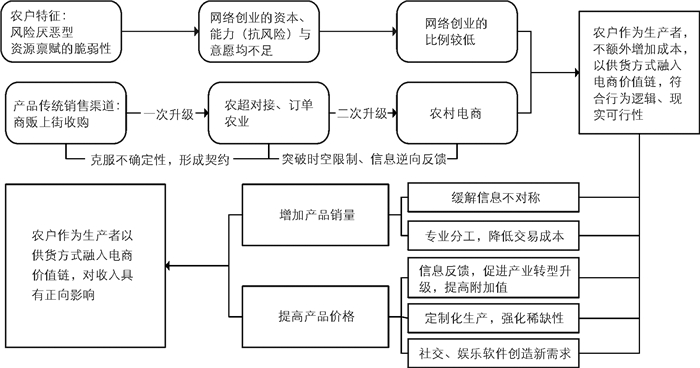全文HTML
-
截至2020年底,我国现行标准下9 899万农村贫困人口全部脱贫,832个贫困县全部脱帽,12.80万个贫困村全部出列,我国的区域性贫困问题得到解决,完成了消除绝对贫困的艰巨任务。但绝对贫困的消除并不意味着脱贫地区永远告别了贫困,正如习近平总书记指出,要看到相当部分贫困群体的脱贫基础还比较脆弱,依然面临艰巨繁重的脱贫地区防止返贫任务……要巩固脱贫攻坚成果并建立解决相对贫困的长效机制。防止返贫、减少相对贫困、实现共同富裕,是“十四五”阶段的新任务。
近年来,随着数字经济的快速发展,电商作为产业扶贫的重要手段,在助推小农户与大市场实现有效对接、拓展农民可持续增收空间方面,发挥了显著的作用。一方面,电子商务通过为农户提供低门槛的农产品销售平台,促使一些有商业头脑、敢于尝试新事物的农户进行网络创业,提升小农户对接大市场的意识与能力。2009年以来涌现的“淘宝村”“淘宝镇”带头人,如江苏省睢宁县沙集镇东风村的村民孙寒等[1-3],多属于此类范畴。不少学者通过理论推理与实证研究发现电子商务创业对农户的收入有显著的正向影响[4-8]。另一方面,与发达地区农户不同,脱贫地区农户的生计资本水平相对较低、创业率较低,绝大多数农户不具备直接进行网络创业的能力与资本[9]。电子商务通过“以销定产”的模式极大地改变了部分农村地区的农业产业结构[10],将当地绝大多数普通小农户纳入产业链的生产端,使其能够分享数字经济发展的效益。
尽管农户参与电子商务价值链的收入效应已得到了一些学者的关注,但现有研究主要集中在以网络创业为主、经济较为发达的地区。而脱贫地区与发达地区的农户在融入电商价值链的方式上具有本质差异,经济发达地区的农户多以网络创业方式直接参与电子商务,而脱贫地区绝大多数农户主要以生产者的身份融入电商价值链,两者从电子商务中获益的方式与程度不同。现阶段对于脱贫地区农户融入电商价值链的相关研究,存在“农户参与电子商务”内涵界定模糊、缺乏微观验证的问题,关于脱贫地区农户融入电商价值链效果的量化分析比较匮乏。因此,本文以云南、贵州、陕西和甘肃4省的7个原国家级贫困县的农户为研究对象,剖析脱贫地区农户融入电商价值链的影响因素,测算其收入效应,并分析不同教育组样本农户融入电商价值链的收入差异。
-
脱贫地区农户以生产者身份融入电商价值链是符合行为逻辑和现实可行性的(如图 1所示)。农户是对新生事物持观望态度又极端风险厌恶的群体,再加上脱贫地区农户资源禀赋的脆弱性,脱贫地区农户直接进行网络创业的资本与能力均不足、抗风险指数极低,这是脱贫地区农村电商发展的主要障碍之一。我国农村一直就有商贩上街收购农户产品的传统销售渠道。农超对接、订单农业能够克服农户销售产品的不确定性,减少市场风险,形成可持续的契约关系,是对商贩上街收购模式的升级。农村电商的介入,又是对订单农业模式的转型升级。农户作为生产者,不仅可与农村电商公司或平台形成可持续的正式或非正式的契约关系,还能根据市场需求及时调整产品生产、提高产品附加值。综上所述,在不增加参与成本的同时,借助政府的支持政策和有效监管,脱贫地区农户作为生产者以供货方式融入电商价值链是符合自身行为逻辑的,在现实层面也是可行的。
脱贫地区农户作为生产者以供货方式融入电商价值链能够稳步增加产品销量。一方面,电子商务具有创业成本低、信息扩散快、信息量全等优点,能够有效解决信息不对称问题,让深巷的酒香能够为外界所知,从而极大增加产品的消费半径,增加产品的销量。另一方面,基于专业分工理论,农户专门从事生产,电商公司或平台主要负责拓展市场,能够极大降低交易成本,从而将更多的资金用以农户能力建设、企业发展和产品培育,进一步增加产品销量,形成良性循环。
脱贫地区农户作为生产者以供货方式融入电商价值链能够提高产品的销售价格。首先,电子商务可以直接获得市场的需求信息,进而对农产品提出一定的采购要求,通过这种模式倒逼相应产业的转型升级,增加产品的附加值,提高产品的价格。其次,电子商务的逆向信息反馈特点有助于实现定制化产品的生产与销售,定制化产品具有较强的稀缺性,价格相应较高。第三,随着社交软件、娱乐软件商务功能的发掘,多样化的营销方式,能够创造出更多产品需求,在供给短期保持不变的情况下,需求增加,产品的价格会相应提高。
农村不乏存在一些新农人,他们接受新事物能力较快,同时具有一定的企业家才能,能够直接网络创业并取得较好的收益。但对于脱贫地区大多数普通农户而言,网络创业的难度与风险均较大,相比之下,从事他们较为擅长的生产工作,为电商公司或组织供货,既能发挥优势、获取可观收益,又不会面临较大风险,是他们乐于接受、收益可观、又切实可行的。从群体平均效应的角度看,在其他因素不变的情况下,脱贫地区农户作为生产者以供货方式融入电商价值链,能够提高产品的销量和价格,对收入具有正向影响。综上,本文提出以下假说:
H1:作为生产者以供货方式融入电商价值链能够提高脱贫地区农户的家庭收入。
-
农户是具有异质性的,农户的人力资本异质性在脱贫地区农村更为凸显[11]。农户人力资本的异质性,会影响农户生产和生活的方方面面,是导致收入差距的重要因素[12]。互联网与电子商务是新的技术变革,人力资本的异质性对农户接受、使用互联网、融入电商价值链并从中受益具有重要的影响[7, 12]。具体分析如图 2所示。
一方面,根据技术接受理论,农户的人力资本特征,会影响农户对新技术变革包括电子商务的主观认知,对电子商务的有用性、易用性形成积极或消极的参与态度,不同农户对电子商务的主观接受意愿具有较大差异。另一方面,户主人力资本的差异,会形成农户生产能力的分化,会对产品经营的规模、产量与质量产生影响[13]。具体而言,随着农户人力资本水平的提高,农户尝试学习新生产技术的可能性增加,学习时间越短、成效越高、管理水平也越高,农户销售给电商公司或组织产品的数量与价格会受到影响,农户融入电商价值链所获取的收入将产生差异。随着农户的人力资本水平的继续提高,农户的经营理念会随之发生变化[14]。碰到商机,农户会有扩大经营规模、组建合作社的想法,可能会引进新的品种,申请产品认证、打造品牌等,进一步规范产品的生产过程。当农户的人力资本水平提高到一定程度后,农户的生计选择将变得多元化[15],可能会选择网络创业,以及其他收益更高的生计策略。
户主通常是家庭的主要决策者,户主的受教育程度是家庭人力资本的重要衡量指标,户主的受教育程度对整个家庭是否融入电商价值链以及融入电商价值链后的收益情况都具有较大的影响,即不同受教育程度的户主所在的家庭,融入电商价值链的情况及收益是有差异的。综上,本文提出以下假说:
H2:融入电商价值链对不同受教育水平农户收入的影响是具有异质性的。
一. 脱贫地区农户融入电商价值链的增收效应:群体平均效应
二. 脱贫地区农户融入电商价值链的增收效应:群体内部差异
-
为准确估计脱贫地区农户融入电商价值链的收入效应,需要考虑以下几个方面的问题:第一,农户是否融入电商价值链存在一定的“自选择”问题,农户家庭收入水平受到众多因素的影响,很可能存在同时影响家庭收入水平和农户是否融入电商价值链的因素,例如家庭成员受教育水平对家庭收入具有较大影响,同时又能决定农户接受新生事物的能力,进而影响农户能否融入电商价值链。样本“自选择”问题将带来变量的内生性问题,进而严重影响到模型估计的准确性。第二,通过调查可以观测到农户融入电商价值链后的收入水平,但无法观测到该农户未融入电商价值链情况下的收入水平,这是一个“反事实”的问题。第三,除了本文选择的影响因素外,还存在其他未观测到的因素也会影响农户的决策行为,从而影响家庭整体的收入水平,该问题也会造成估计结果的偏差。
针对以上问题,国内外学者多采用倾向得分匹配法(PSM)进行分析[7-8, 16-18]。一方面,利用反事实分析方法中的PSM不仅能够有效缓解由于样本“自选择”问题带来的估计偏差,而且处理变量内生性问题时,不需要另外设定工具变量或者限定函数、参数或者误差分布的形式。另一方面,倾向得分匹配法与回归等其他方法相比,其优势在于可以“还原”处理组不融入电商价值链的状态以及控制组融入电商价值链的状态,通过把基本特征相似的处理组和控制组进行匹配,克服只能观测到农户“融入电商价值链后未来的收入水平”或“不融入电商价值链后未来的收入水平”的难题,从而测量农户融入电商价值链对收入的影响。
在进行倾向得分匹配时,首先要计算样本的倾向得分,倾向得分的计算方法多采用普通的Logit或Probit二值模型,但当样本中“y=1”发生的比率较小时,若仍然使用普通的二值模型估计,可能会造成结果的偏差。
对于二值选择模型,当“y=1”发生的频率较小时,称为“稀有事件”(rare events)[19]。解决稀有事件偏差的方法主要有三种,一种是King等提出的小样本偏差纠正法,该方法继续使用Logit模型,但会对偏差进行纠正[20]。King等采用此方法分析了二战后国际关系问题[21]。第二种方法是陈强提出的非对称的“极值分布”(extreme value distribution)法,即“补对数-对数模型”[19],其事件发生概率为公式(1),其中x′β=ln[-ln(1-p)],取了发生概率p的补数的两次对数,即极值分布左偏(left-skewed),使得事件发生概率p趋于1的速度快于趋于0的速度,避免了稀有事件中若直接采用Logit和Probit模型,事件发生概率p趋于1的速度等于趋于0的速度造成的估计偏差。陈强采用此方法分析了中原王朝被游牧民族征服的决定因素[22]。第三种方法是泊松回归,泊松分布是二项分布的近似,且泊松分布在事件发生概率很小时(无限趋近于0时)也成立,故也称为“稀有事件定律(Law of rare events)”。
脱贫地区以供货方式融入电商价值链的农户数量为221户,发生率约为14.13%,若使用普通二值模型估计倾向得分,可能会导致“稀有事件偏差”(rare event bias)。因此,本文分别采用普通二值模型(Logit模型和Probit模型)、稀有事件模型(“补对数-对数模型”和泊松分布)两类方法互相印证。
-
本文数据来源于2018年7月-8月,中国农业科学院农业信息研究所关于云南、贵州、陕西和甘肃4省,会泽、正安、武定、洛南、盘县、镇安和清水7县的农户的贫困专题调研。该调研采用多阶段抽样法选取样本,第一阶段,采用聚类分析法,将全国592个贫困县按照综合食物安全和贫困状况聚类为三类,采用专家判断法在最差类中选取样本省和样本县,即云南省武定县和会泽县、陕西省镇安县和洛南县以及贵州省的盘县和正安县、甘肃省清水县,第二阶段采用PPS抽样法,按贫困人口规模比例选取样本村,每个县选取19个村(其中甘肃省选16个村),共计130个村,第三阶段,采用系统抽样法,每个村随机选取12个农户,共计1 564个农户①。
① 在实际调研过程中,部分追踪农户因种种原因无法访问,故多选取了一些相似的农户(4户),供后期研究。
该调研的问卷内容涉及家庭成员年龄、职业、婚姻状况、受教育程度、健康状况、受培训情况、外出务工等基本信息,互联网接入与使用、网络购物、网络销售、电子商务服务发展等相关信息,住房和生活条件,家庭财产与财务状况,农业、生计、支出、冲击和应对策略、扶贫项目和赋权等10多项内容。本文所采用数据来源于基本信息、互联网接入与使用和电子商务发展等相关信息、家庭财产与财务状况、农业部分。
-
农户是否融入电商价值链:农户融入电商价值链有多种形式,例如网络销售创业、电子商务产业链就业、提供货源、网络购物等,农户从电子商务中受益的方式也有多种,例如直接的创业致富、就业增收、网络购物节约支出等。本文所研究的农户融入电商价值链Ecommerce,是指农户是否为电商公司或组织提供货源、间接在网上销售产品,即农户是否以供货方式融入电商价值链。该变量为0/1变量,若农户为电商公司或组织提供货源,则Ecommerce取值为1,否则为0。
农户收入水平:lnincome是指经营性收入、工资性收入、转移性收入和财产性收入等所有收入之和的对数。具体而言,经营性收入包括种植业收入(种粮收入、经济作物收入和其他种植业收入),林业收入(干果、树苗等收入),养殖业收入(家禽、水产品等收入),家庭食品手工作坊收入,手工艺收入,商业收入、家庭经营服务性收入等。工资性收入包括打零工收入和稳定工资收入。转移性收入包括政府各项补贴和津贴,来自亲戚、朋友的汇款收入,礼金收入和其他转移性收入等。财产性收入包括土地租金、生产工具租金、分红等。为了保证数据的平稳性,以及考虑到取对数后的经济学意义,本文对农户收入水平作取对数处理。
-
在宏观层面:(1)随着国家把电商扶贫作为主流的扶贫手段,商务部、农业农村部等多部门制定了一系列支持农村电商发展的政策。地方政府也相应制定了实施方案,申请国家级电子商务示范县、建立县级电子商务中心、镇级和村级电商服务站等,引导农户使用互联网、参与电子商务,促进工业品的下行和农产品的上行。因2018年的电子商务示范县是在9月份评选出来,相关政策支持会在9月份之后才能享受,而本调研开展的时间是2018年7-8月,故本文涉及的变量主要涉及“是否是2016年和2017年的电子商务示范县”“本村是否有支持电商扶贫的政策”2个变量。(2)地理位置是影响物流的重要因素,经济发展水平决定了当地的公共服务、配套设施水平,这些都是电子商务得以发展的必要因素。本文涉及的变量主要是地理位置的虚拟变量,村中是否有电子商务服务站,以及农户到最近的市场距离3个变量。(3)特色产业是农产品上行的基础,能够网络销售的商品与当地市场销售的商品,在品质、种类、数量、品牌、价格等属性方面有较大的不同,这就对商品的产业基础要求较高。本文选取的相关变量为“农户是否参与特色产业扶贫”1个变量。
在微观层面:(1)人力资本包括人的健康、体力情况,以及人的生产能力和技能[23]。农户的健康状况越好、生产能力越强,学习、接受新事物的能力越强,融入电商价值链的可能性就越大。本文的人力资本变量主要涉及是否参与生产类和电子商务类培训、劳动力人均受教育年限、家中是否有人网络购物3个变量。(2)社会资本主要指个人或团体之间的关联,这种关联包括社会网络、互惠性规范和由此产生的信任,使人们在社会结构中所处的位置给他们所带来的资源[24],表现形式主要有农户的职业、参加的组织[25]。农户的社会资本越多,接触、学习参与电子商务的可能性就越大。本文的社会资本变量主要涉及家中是否有村干部、是否加入合作社2个变量。(3)金融资本是指农户所享有的金融资源或服务,通常包括农户能支配的现金收入,以及可获得的融资渠道。农户能享受到的金融资源或服务越多,提高农产品生产能力与投资的可能性越大,尝试融入电商价值链的可能性就越高。本文选取农户是否能从银行或信用社借到钱作为衡量指标。
除了上述因素,农户家庭的一些基本信息也会影响农户融入电商价值链的决策,例如不同家庭劳动力数量、劳动力平均年龄、贫困情况和土地数量等,可以作为控制变量进入模型。
综上所述,影响农户融入电商价值链的变量设置及其描述性统计结果如表 1所示。本文分别计算了所有变量(除了处理变量和结果变量外)的相关系数,发现变量间的相关系数分布在0.00~0.42之间,相关系数的最大值为0.42,次大值为0.35,其余值均在0.30以下。可以认为,变量间的相关系数较低,不存在严重共线性问题,可以进一步采用相关计量模型进行分析。
一. 模型选择
二. 数据介绍
三. 变量设置
1. 核心变量
2. 其他变量
-
为了保证结果的稳健性,本文首先采用“稀有事件模型”“补对数-对数模型”,普通二值模型即Logit和Probit模型,相互印证,估计农户融入电商价值链的倾向得分。第二步,分别采用核匹配法进行倾向得分匹配,并根据“自举法”计算处理组效应、控制组效应和总体平均效应。第三步,进行匹配变量的平衡性检验。
根据倾向得分匹配法,第一步采用上述模型估计农户融入电商价值链的倾向得分,依据得分进行匹配,进而计算处理组和控制组的处理效应。表 2为模型的回归结果,表 3为相应的模型的边际效应结果,从中可以看出,四种模型的估计结果比较相似,回归的系数和边际效应的符号一致。
在影响农户融入电商价值链的宏观因素方面,当其他条件一定时有以下结论:(1)村里有电子商务支持政策,农户融入电商价值链的概率会增加18% ①。村民自治委员会与村民的关系较为密切,对村民最为熟悉,所做的决策对村民的影响也是最直接的。一方面,村里制定的相关支持电子商务发展的优惠政策会更加因地制宜,更能有效地缓解或解决农户发展电子商务过程中遇到的困难。另一方面,村民对村民自治委员会及其政策相对信任,思想开放的农户更容易相信政策的真实性、可行性并尝试从事电子商务,并提高自己的收入水平。(2)村里有电子商务服务站,农户融入电商价值链的概率会增加5.96%。村级电子商务服务站的主要功能包括帮农户代买网上的商品、代卖农户的产品、代农户缴电话费、电费等各种费用,简称“代买、代卖和代缴”。随着电子商务服务站的下沉,农户不仅可以真切体验享受到互联网带来的便捷,打破对互联网摸不着、靠不着的模糊认知,农户还能借助电子商务服务站网络销售产品,增加融入电商价值链的可行性。(3)其他变量的影响是不显著的。
① 因稀有事件模型结果中,泊松分布的结果相对稳定,这里均以泊松分布的边际效应结果为主。
在影响农户融入电商价值链的微观因素方面,当其他条件一定时有以下结论:(1)农户家庭成员有网购行为,农户融入电商价值链的概率会增加5.42%。网络购物本身就是电子商务,不同之处在于网络购物过程中,农户是作为消费者参与电子商务的,而网络销售的过程,是农户作为生产者参与电子商务的。虽然农户的角色不同,但这只是电子商务这枚硬币的两面而已。当农户家庭成员中有人体验、享受过网络购物后,整个农户家庭对互联网,尤其是电子商务的认知就更近了一步,无论是打破农户对电子商务过程的认知障碍,还是熟悉电子商务的交易过程、从消费者角度揣摩顾客心理,均增加了农户从消费者转变为生产者的可能性。(2)农户能够从银行或信用社贷款,农户融入电商价值链的概率会增加9.31%。农户能从银行或信用社获取贷款增加了其金融资本,金融资本的增加促使农户能够扩大产品的生产规模、提升产品的附加值,还可能会进行产品的质量认证、品牌的塑造,进而尝试通过网络销售产品,增加销量和利润。(3)农户的平均受教育水平越高,农户融入电商价值链的概率会降低0.48%。农户的受教育水平越高,可供农户选择的就业领域越广,农户融入电商价值链的机会成本比较大。(4)其他变量的影响是不显著的。
接下来分析农户融入电商价值链的收入效应。图 3为处理组和控制组倾向得分的核密度分布图,倾向得分越高,农户融入电商价值链的可能性就越大。处理组和控制组的样本绝大部分都在共同取值范围内,故匹配时不会损失大量样本。控制组的概率分布先不断增加至0.17附近,并达到峰值,随后快速下降,然后保持平稳。处理组的概率分布先不断增加,与控制组在0.09附近第一次相交后,增加至0.20附近达到峰值,随后不断降低,与控制组在0.22附近第二次相交,随后保持稳定。两组概率分布第一次相交以前以及第二次相交以前,控制组的频数多于处理组,这表明控制组以较小可能性融入电商价值链的户数多于处理组以较小可能性融入电商价值链的户数。两组概率分布第二次相交后,处理组的频数多于控制组,这表明处理组以较大可能性融入电商价值链的户数高于控制组以较大概率融入电商价值链的户数。
根据处理组和控制组的倾向得分值,用核匹配法进行匹配,对比处理组和控制组的收入差异,如表 4所示。在匹配前,采用最小二乘法估计,发现处理组比控制组农户的总收入高26.24%,利用倾向得分匹配后,处理组的收入效应为22.97%,控制组的收入效应为22.01%,综合看来,在控制了政策、区位、产业、人力资本、社会资本、金融资本等系列因素后,农户融入电商价值链使云南、贵州、陕西和甘肃的农民家庭总收入平均提高了22.24%,即处理组、控制组及总体的处理效应差别不大,在22.01%~22.97%之间。ATT的T值大于临界值2.56,则处理组的平均处理效应在1%的显著性水平下是显著的。
从表 4可看出,采用最小二乘法得到的收入提高比例,远远高于以倾向得分匹配法得出的收入提高比例,原因在于最小二乘法忽略了个体之间的差异,导致得出融入电商价值链对收入改善作用非常大的伪结论。倾向得分匹配法,通过控制农户的特征值,配对后再进行比较,正好处理了个体间差异的影响,得出更为真实的结论。因此,采用倾向得分匹配法是较为合理的。
根据自举法,估计参与者的处理效应、未参与者的处理效应和综合的平均处理效应,可以看出,ATT、ATE、ATU均在1%的显著性水平下显著。这表明,样本之间匹配的结果较为稳健,本研究所得出的结论较为可信。
根据平衡性检验结果可知,匹配结果较好地平衡了数据,大多数的变量标准化偏差(%bias)在10%左右,对比匹配前的结果,大多数变量的标准化偏差均大幅减少; 另外,大多数变量T检验概率值均大于0.10,表示在10%的显著性水平下,均不能拒绝原假设(原假设为匹配后的处理组与控制组无显著差异),可以认为,本文选择的匹配变量和匹配方法是合适的。
综上可知,无论是“补对数-对数模型”、泊松分布,还是Logit和Probit模型,农户融入电商价值链的倾向得分估计结果和边际效应结果均比较相似,变量显著性几乎一致,且各变量的估计系数大小非常接近,边际效应及其显著性也高度一致。在农户融入电商价值链的收入处理效应方面,四种方法得到的ATT、ATU和ATE的数值几乎相等,仅小数点之后略有不同,显著性也完全一致。在核密度图的分布上,四种模型无论是趋势还是相交点,图形走势非常一致。因此,本文所得到的结论均高度一致,结论稳健性较好,结论较为可信。综上,假说1得到证实。
-
农户的受教育水平是影响其融入电商价值链的重要因素[7, 24],而户主作为农户家庭的主要成员,户主的受教育水平对农户家庭的重大决策,具有重要的影响。不同受教育程度的户主所在的家庭,可能会呈现出不同的特征。因此,本文基于户主的受教育程度,将农户分为文盲组、小学组、初中组和高中及以上组,采用倾向得分匹配法①,进而分析不同组别的农户组融入电商价值链的收入效应。
① 这里以“泊松分布”的估计结果为例。
表 5为倾向得分的估计结果,从中可以看出,属于电子商务示范县、村中有电子商务支持政策、属于陕甘地区、村中有电子商务服务站、到市场的距离、参与产业扶贫项目、平均受教育年限、参与合作社、家中成员有网购行为、能够从银行或信用社贷款对不同组别的农户融入电商价值链有显著的正向或负向影响。泊松模型的边际效应结果中,所有变量的系数方向均与表 5相同,且系数的显著性也基本一致。因本文主要关注不同受教育程度组别的农户融入电商价值链的收入效应,故倾向得分估计及其边际效应估计的变量系数符号及大小的结果及原因,这里不再赘述。
表 6为不同组别的农户融入电商价值链的收入效应的结果,从中可以看出,无论是普通的方法还是利用“自举法”得到的结果,结论非常一致。对于文盲组和高中及以上组,无论是处理组、控制组还是总体样本,农户是否融入电商价值链对收入的影响均是不显著的,即户主未接受正式教育的农户融入电商价值链与不融入电商价值链,对收入的影响没有差异。
对于小学组,农户融入电商价值链的收入效应均在1%的显著性水平下显著; 处理组农户融入电商价值链比不融入电商价值链,收入能够提高30.99%;对于控制组农户,农户融入电商价值链比不融入电商价值链,收入能够提高28.66%;对于处理组和控制组总体而言,农户融入电商价值链比不融入电商价值链,收入能够提高29.22%。
对于初中组,农户融入电商价值链的收入效应均在5%的显著性水平下显著; 处理组农户融入电商价值链比不融入电商价值链,收入能够提高17.50%;对于控制组农户,农户融入电商价值链比不融入电商价值链,收入能够提高21.41%;对于处理组和控制组总体而言,农户融入电商价值链比不融入电商价值链,收入能够提高20.55%。
综上可知,户主受教育水平与融入电商价值链增收效应呈现倒U型关系,即小学和初中组农户融入电商价值链的增收效应比较显著,并且小学组的农户增收效应大于初中组,而文盲组与高中及以上组农户增收效应不显著。这表明融入电商价值链对于脱贫地区农户具有教育门槛效应,对低受教育水平农户具有高度包容性和益贫性。原因主要在于,电子商务对文盲群体存在明显的门槛效应,而受教育水平越高的群体(高中及以上)往往从业机会越多,收入水平也较高,融入电商价值链带来的收入差异并不大。农户以供货方式融入电商价值链并不需要过高的受教育水平,农户户主的受教育水平越低,可供选择的职业范畴越窄,一些高收入职业的门槛相对较高,而融入电商价值链的门槛相对较低,电子商务对于产品销量和利润的影响又较大,这样农户是否融入电商价值链的收入差异就越大。综上,假说2得到证实。
-
本文基于2018年7月-8月,中国农业科学院农业信息研究所关于云南、贵州、陕西和甘肃4省,会泽、正安、武定、洛南、盘县、镇安和清水7县农户的贫困专题调研数据,以1 564户农户为研究对象,论述了脱贫地区农户融入电商价值链的增收机制,采用倾向得分匹配法,并结合稀有事件模型,从政策、地理区位、产业基础、人力资本、社会资本、金融资本等方面设置变量,分析了脱贫地区农户以供货方式融入电商价值链的影响因素与收入效应,并进行了稳健性检验和异质性分析。相关结论如下:脱贫地区农户作为生产者以供货方式融入电商价值链能够增加销量、提高价格,增加收益。村中有电子商务支持政策、村里有电子商务服务站、农户有网络购物行为、劳动力平均年龄、能从银行或信用社贷款五个因素对脱贫地区农户融入电商价值链的影响是正向的,劳动力平均受教育年限因素的影响是负向的。在控制了政策、区位、产业、人力资本、社会资本、金融资本等系列因素后,以供货方式融入电商价值链的农户比不融入电商价值链的农户,收入平均高22.24%。进一步,基于户主受教育水平,将农户分为文盲组、小学组、初中组与高中及以上组,发现农户受教育水平与融入电商价值链增收效应呈现倒U型关系,即小学和初中组农户融入电商价值链的增收效应比较显著,小学组的农户增收效应大于初中组,而文盲组与高中及以上组农户增收效应不显著,即电商价值链对于脱贫地区农户具有教育门槛效应,对低受教育水平农户又具有高度包容性和益贫性。
结合上述结论,提出以下几个层面的政策建议。第一,中央和地方政府应继续增加促进脱贫地区农村电子商务发展的政策,尤其是在资金、服务站建设、农户培训方面的政策支持,为农户提供良好的宏观制度环境。第二,电子商务服务站的介入,能够在一定程度上解决工业品下行最后一公里、农产品上行最初一公里的难题。但现阶段脱贫地区多数电子商务服务站的农产品上行功能不健全,亟待进一步开发。第三,针对农户面临的资金难题,在有效监管的前提下,政府可以逐步放开农村金融市场,盘活农村的金融资源。贷款业务在农村的门槛相对较高,一方面意味着农户贷款困难,也反映出了金融机构给农户贷款后可能面临的还款困境,这不仅需要国家在贷款资格方面的政策干预,更需要对农户所拥有的住房、土地等财产进行赋权,以及相关保险业务的开展,以确保贷款的顺利进行。第四,要重视低收入文盲群体人力资本的提升,通过夜校、实训等方式提升其受教育水平和互联网技术应用能力,从而促进其融入电商价值链进而增加收入的能力。




 下载:
下载:

